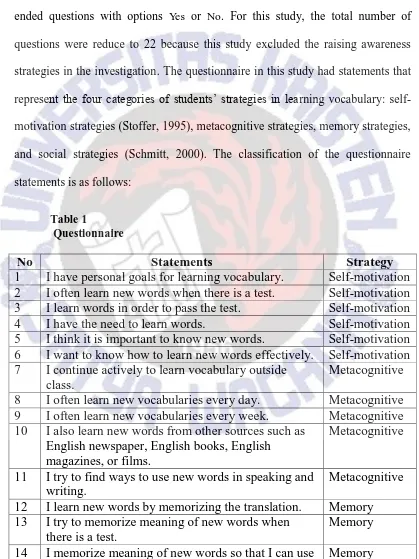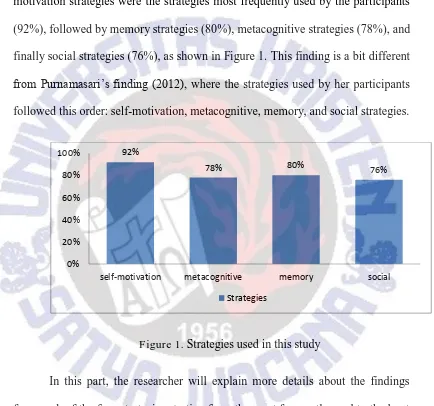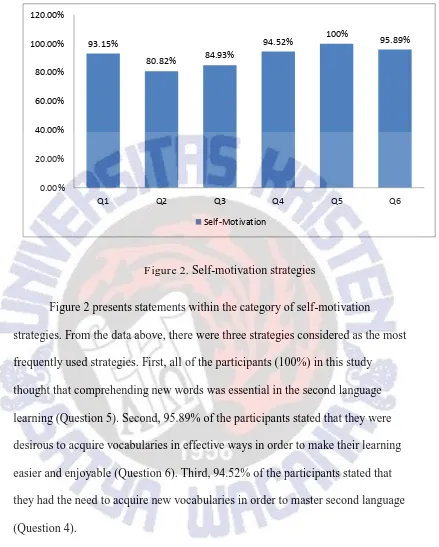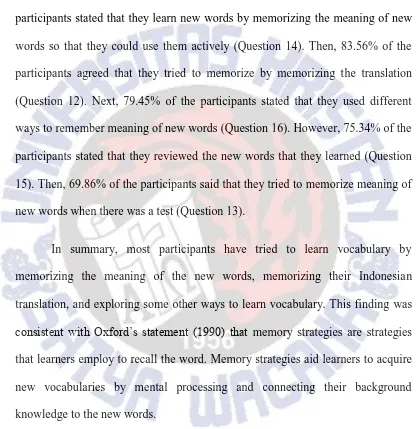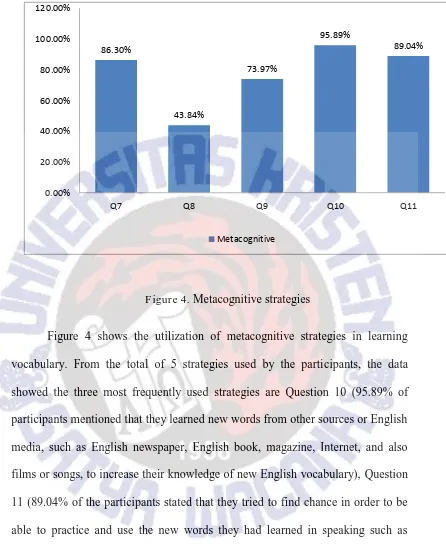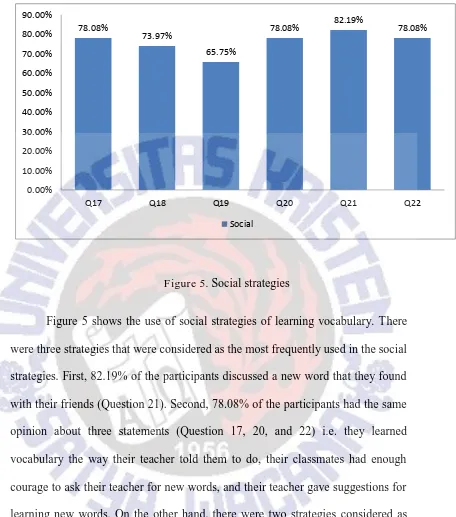i
VOCABULARY LEARNING STRATEGIES BY THE FRESHMEN IN AN ENGLISH LANGUAGE EDUCATION PROGRAM
THESIS
Submitted in Partial Fulfillment of the Requirements for the Degree of
Sarjana Pendidikan
Claudia Alma Putri Mamesah NIM: 112013081
ENGLISH LANGUAGE EDUCATION PROGRAM
FACULTY OF LANGUAGE AND ARTS
UNIVERSITAS KRISTEN SATYA WACANA
SALATIGA
iii
vii
Table of Contents
Cover Page ... i
Pernyataan Tidak Plagiat... ii
Pernyataan Persetujuan Akses ... iii
Approval Page ... iv
Copyright Statement ... v
Publication Agreement Declaration ... vi
ABSTRACT... 1
INTRODUCTION ... 2
REVIEW OF LITERATURE... 3
THE STUDY ... 7
Type of the Study ... 7
Context of the Study ... 8
Participants of the Study ... 8
Data Collection Instrument ... 8
Data Collection Procedure ... 10
Data Analysis Procedure ... 10
FINDINGS AND DISCUSSIONS ... 11
CONCLUSION ... 18
ACKNOWLEDGEMENTS ... 20
REFERENCES ... 21
1
VOCABULARY LEARNING STRATEGIES BY THE FRESHMEN IN AN ENGLISH LANGUAGE EDUCATION PROGRAM
Claudia Alma Putri Mamesah 112013081
ABSTRACT
Vocabulary learning is one of the most important challenges that learners will face throughout the language learning process. Vocabulary has been considered as important to language use in which insufficient vocabulary knowledge of the learners led to difficulties in language learning. Coady and Huckin (1999) said that the critical importance of vocabulary in all languages is undeniable because it does not only establish cognitive systems of knowledge, but also facilitates the communicative and comprehensive interaction. Further, the use of vocabulary learning strategies also affects learners’ performance. This study aims to describe strategies used by students of Batch 2016 of the English Language Education Program of the Faculty and Language and Arts of Universitas Kristen Satya Wacana, Salatiga in learning vocabulary. Based on the purpose of this study, the best method for this study is descriptive qualitative. A total of 73 students responded to 22 closed-ended questions with options Yes or No which was designed based on theory proposed by Stoffer (1995) and Schmitt (2000). The result of this study revealed the most frequently used strategies is self-motivation.
2
INTRODUCTION
Learners who learn a second language will learn several skills such as writing, reading, speaking, and listening. In order to support their performance in those skills, they need to enlarge their vocabulary because it is one of the important things in all languages. Coady and Huckin (1999) said that the critical importance of vocabulary in all languages is undeniable because it does not only establish cognitive systems of knowledge, but also facilitates the communicative and comprehensive interaction. Actually, I feel that as a student in the Faculty of Language and Arts, I need to enlarge my vocabulary list and I really want to know what kind of strategies that I can use to enlarge my vocabulary list so that I can choose the best strategies of learning vocabulary for myself.
When learners want to enlarge their vocabulary, they need to find a strategy to learn it. There are several strategies to learn vocabulary, comprising memory strategies, metacognitive strategies, social strategies, determination strategies, and cognitive strategies (Oxford (1990) as cited in Schmitt (2000)). Those strategies can help students to learn vocabulary in order to make them survive in learning a second language. In this study I want to know what strategies that freshmen in the English Language Education Program of the Faculty of Language and Arts of Universitas Kristen Satya Wacana used to learn vocabulary in order to enlarge their vocabulary list.
3
to help their students to learn vocabulary more efficiently. Moreover, I expect that the current study would give useful information for the faculty’s students to be
more aware of the strategies they have applied in learning vocabulary and use the strategies that suit them.
REVIEW OF LITERATURE
In the old days of language teaching, vocabulary learning and teaching were given little importance in education. As Moir and Nation (2008) wrote that lexical instruction was not important, the teaching of vocabulary was therefore not popular (Nation, 1990). However, nowadays the significance of vocabulary in learning a language has become more accepted. As said by Coady and Huckin (1999), we cannot deny the critical importance of vocabulary in all languages because it does not only establish cognitive systems of knowledge, but also facilitate the communicative and comprehensive interaction.
Moreover, Paribakht and Wesche (1999) noted that vocabulary acquisition is a continuous process that involves the integration of various kinds of knowledge along with gaining different levels of ability to make use of that knowledge in communication. According to Schmitt (1997), vocabulary learning strategies are even more important in learning a second language with the increasing nature of vocabulary acquisition and its emphasis on large exposure to the language.
4
that vocabulary is an important thing in order to succeed on language learning. Moreover, Cogan (2002) mentioned that the limited number of vocabulary that someone has may cause him/her to get into trouble in learning a foreign language since he/she cannot get information well when he/she reads or listens, and he/she cannot freely express his/her concepts and ideas when he or she writes or speaks.
Learning strategies can help the second language learners become better, independent and confident learners (Chamot, 1999). The particular strategies used by second language learners for the acquisition of new words in the second language are called “vocabulary learning strategies” (Gu, 1994).
Further, there is a wide range classification of different second language vocabulary learning strategies suggested by some researchers. One of them is Schmitt (2000), who classified vocabulary learning strategies, based on Oxford (1990)’s language learning strategies taxonomy into determination, social,
5
words, and highlighting new words. The last, metacognitive strategies give learners opportunities to learn, record, and review those experiences. In other words, metacognitive strategies are monitoring, decision making, and assessment of learners’ advance. They also help learners to specify suitable strategies in
learning vocabulary.
Then, another researcher, Stoffer (1995), design the classification of strategies in vocabulary learning containing nine individual strategies: strategies involving authentic language, strategies involving creative activities, strategies used for self motivation, strategies used to create mental linkages, memory strategies, visual strategies, strategies to overcome anxiety, strategies used to organize words, and strategies involving physical actions.
Richard and Renandya (2002) in their introduction mentioned, “Vocabulary is a core component of language proficiency and provides much as
the basis for how well learners speak, listen, read, and write” (p.255). If L2
6
BeiZang (2011) conducted a research about strategies that students used in learning vocabulary. The research was conducted at Kristianstad University, China. The aim of the study was to get the efficient strategies used by Chinese English major students in vocabulary learning, and to find what strategies had a positive effect on the students’ vocabulary learning. In addition, the study was also trying to investigate what methods the students with good learning efficiency have in common. The study was based on qualitative research, in which 35 college students were investigated. The participants were asked to take a vocabulary test and complete a questionnaire. The data of the research indicated that there were significant differences between effective and less effective learners, and common points between effective learners. Effective learners use several learning methods and have a positive attitude. There are six methods they use in common; having interest in English, listening and reading, learning words in sentence, using bilingual dictionary, reading English books in spare time and studying the spelling.
7
students from batch 2011. Although the study involved participants from different batches, it regarded the participants as one whole group. The participants were asked to complete a questionnaire. The finding of the research indicated several things. First, the participants were aware of vocabulary. Second, the participants tended to have high motivation in learning new vocabulary. Third, the participants were able to control and monitor their own learning. Next, the participants used memory strategies for specific and useful purposes. It was proven by the most frequently used strategies by the participants was memorizing meaning of new words. Last, the participants tended to learn new vocabulary with their classmates or friends rather than with their teacher.
THE STUDY
Type of the Study
This section describes the method used in doing this research study, the participants, and how the data were collected and analyzed.This study is a replication study from Purnamasari (2012) that used a descriptive qualitative method. Following Landman’s (1988, as cited in Purnamasari, 2012) explanation
of a descriptive study, this study aims to identify the use of strategies in learning vocabulary by describing the nature or conditions of the participants’ current
situation.
However, unlike Purnamasari’ study (2012) that involved students of five
8
and Arts of Universitas Kristen SatyaWacana to learn vocabulary. My goal in doing this study is to give information to lecturers on how their students apply strategies in learning vocabulary so that they would be able to help their students to learn vocabulary better. In addition, this study would hopefully give information to students to be more aware of strategies they have applied in learning vocabulary and of strategies that may suit them better.
Context of the Study
This study was conducted in the Faculty of Language and Arts (FLA) of Universitas Kristen Satya Wacana. The university is located in Salatiga, a small city in Central Java, Indonesia. The Faculty of Language and Arts has three programs, including English Language Education Program, English Language Literature Program, and Music Program.
Participants of the Study
The participants in this study were all students of Batch 2016 (73 students) of the English Language Education Program of the FLAof Universitas Kristen Satya Wacana, Salatiga, Indonesia. The reason why I chose students of Batch 2016 or the freshmen as my participants is because as the freshmen, they need to struggle in the FLA longer than the other batches, and it would be helpful if they could recognize the strategies that may be suitable for them to learn vocabulary.
Data Collection Instrument
9
Purnamasari’s study (2007) with some changes in number of questions, personal
information part, question or statement part and word choice. She was an English Language Education program graduate from Batch 2007 whose study I replicated. The questionnaire was originally written in English and it consisted of 33 closed-ended questions with options Yes or No. For this study, the total number of questions were reduce to 22 because this study excluded the raising awareness strategies in the investigation. The questionnaire in this study had statements that represent the four categories of students’ strategies in learning vocabulary: self-motivation strategies (Stoffer, 1995), metacognitive strategies, memory strategies, and social strategies (Schmitt, 2000). The classification of the questionnaire statements is as follows:
Table 1
Questionnaire
No Statements Strategy
1 I have personal goals for learning vocabulary. Self-motivation 2 I often learn new words when there is a test. Self-motivation 3 I learn words in order to pass the test. Self-motivation 4 I have the need to learn words. Self-motivation 5 I think it is important to know new words. Self-motivation 6 I want to know how to learn new words effectively. Self-motivation 7 I continue actively to learn vocabulary outside
class.
Metacognitive
8 I often learn new vocabularies every day. Metacognitive 9 I often learn new vocabularies every week. Metacognitive 10 I also learn new words from other sources such as
English newspaper, English books, English
12 I learn new words by memorizing the translation. Memory 13 I try to memorize meaning of new words when
there is a test.
Memory
10 it actively.
15 I always review new words that I learn. Memory 16 I use different ways to remember meaning of new
words.
Memory
17 I learn vocabulary the way the teacher tells me to do.
Social
18 The teachers help me individually to understand new words.
Social
19 The teacher gives time to me to ask meaning of new words.
Social
20 The students in my class have enough courage to ask the teacher for new words.
Social
21 When I find new words, I discuss it with my friends Social 22 The teacher gives suggestion for learning new
words.
Social
Data Collection Procedure
The questionnaire was administered at the end of the class hours so students could concentrate in filling out the questionnaire. The respondents were asked to provide personal information (student number) and answer 22 questions. It took about 5 to 7 minutes and they were asked to answer honestly and submit the questionnaire after they finished filling it out.
Data Analysis Procedure
11
FINDINGS AND DISCUSSIONS
The aim of this chapter is to analyze the data gathered. The discussion of the analysis result was based on the four main strategies that were mentioned previously. According to the data analysis, the researcher found that self-motivation strategies were the strategies most frequently used by the participants (92%), followed by memory strategies (80%), metacognitive strategies (78%), and finally social strategies (76%), as shown in Figure 1. This finding is a bit different from Purnamasari’s finding (2012), where the strategies used by her participants
followed this order: self-motivation, metacognitive, memory, and social strategies.
Figure 1. Strategies used in this study
In this part, the researcher will explain more details about the findings from each of the four strategies starting from the most frequently used to the least (self-motivation, memory, metacognitive and social strategies).
92%
78% 80% 76%
0% 20% 40% 60% 80% 100%
self-motivation metacognitive memory social
12
Figure 2. Self-motivation strategies
Figure 2 presents statements within the category of self-motivation
strategies. From the data above, there were three strategies considered as the most frequently used strategies. First, all of the participants (100%) in this study
thought that comprehending new words was essential in the second language learning (Question 5). Second, 95.89% of the participants stated that they were desirous to acquire vocabularies in effective ways in order to make their learning easier and enjoyable (Question 6). Third, 94.52% of the participants stated that they had the need to acquire new vocabularies in order to master second language (Question 4).
The three strategies in self-motivation that were considered as the least used strategies employed by the respondents include Question1 (I have personal goals for learning vocabulary, 93.15%), Question 3 (I am motivated because I
13
want to pass the test, 84.93%), and Question 2 (I only learn new words when there is a test, 80.82%).
From the data above, it could be summed up that it was important to enlarge the vocabulary size. It was proven by the finding that all of the participants believed the importance of mastering new words in second language learning process. The finding is consistent with Kulikova’s statement (2015) that “words are often called the building blocks to success on the way to language proficiency. Taken together, these building blocks constitute people’s
vocabularies.” (p.1). It can be interpreted that vocabulary is an important thing in
order to succeed on language learning. On the other hand, a few participants showed low motivation in learning vocabulary. They stated that learning new words was needed onlyif there was a test or in order to pass the test. Actually, all the statements receive above 80% YES answer. It means that all the participants had high motivation in order to enlarge their vocabulary list.
14
Figure 3. Memory strategies
Figure 3 presents the memory strategies employed by the participants in their vocabulary acquisition. According to the result above, there were three strategies considered as the most frequently used strategies. First, 93.15% of the participants stated that they learn new words by memorizing the meaning of new words so that they could use them actively (Question 14). Then, 83.56% of the participants agreed that they tried to memorize by memorizing the translation (Question 12). Next, 79.45% of the participants stated that they used different ways to remember meaning of new words (Question 16). However, 75.34% of the participants stated that they reviewed the new words that they learned (Question 15). Then, 69.86% of the participants said that they tried to memorize meaning of new words when there was a test (Question 13).
In summary, most participants have tried to learn vocabulary by memorizing the meaning of the new words, memorizing their Indonesian translation, and exploring some other ways to learn vocabulary. This finding was consistent with Oxford’s statement (1990) that memory strategies are strategies
15
Figure 4. Metacognitive strategies
16
73.97% of the participants stated that they often learned new words every week (Question 9) and only 43.84% of the participants sorted that they learned new words everyday (Question 8).
17
Figure 5. Social strategies
18
From the data, it could be concluded that most of the participants liked to share their ideas and arguments with their classmates better than directly involving their teacher in learning vocabulary. Most of them stated that they discussed new words they found with other friends in class. This finding was consistent with Schmitt’s statement (2000) that social strategies aid learners to interact with other people and learn from each other.
CONCLUSION
This paper reports on a study intended to describe the vocabulary learning strategies used by English Language Education students in their vocabulary learning process. Among the four categories investigated in this study, such as strategies used for self-motivation, metacognitive strategies, memory strategies, and social strategies, this study summed up that self-motivation strategies were the strategies most frequently used by the participants. Memory strategies, metacognitive strategies, and social strategies followed afterwards.
19
Regarding the findings, the researcher suggests the learners to have high motivation in order to enlarge their vocabulary list. Moreover, the the researcher also suggest the teacher to motivate their learners to enlarge their vocabulary list.
This study was not without a weakness. It was hard for the researcher to get more information from the participants about their answer since most of them did not want to give his/her personal information to the researcher. Perhaps for future research the researcher could give explanation or reason to the respondents more clearly why the researcher asked their personal information. Moreover, the researcher could conduct the research not only in quantitative approach but also in qualitative approach to know the individual’s differences in order to find some
20
ACKNOWLEDGEMENTS
First of all, I would like to give my greatest gratitude to my Almighty God, Jesus Christ. I would never be able to finish this thesis without His blessings and grace. Then, I would like to thank my supervisor, Ma’am Gita Hastuti, M.A. for
21
REFERENCES
Chamot, A. U. (1999). Learning strategy instruction in the English classroom. Retrieved on
January, 14 2017 from http://www.Jalt-publications.org/tlt/article/1999/Chamot/.
Coady, J., &Huckin, T. (Eds.). (1999). Second language vocabulary acquisition. Cambridge:
Cambridge University Press.
Cogan, J. (2002). Learning Vocabulary. Retrieved on January, 14 2017 on the World
Http://homepages.Westminister.org.uk/classics/vocab/learning.html.
Grabe, W. (2009). Reading in a Second Language: Moving from Theory to Practice. Cambridge: Cambridge University.
Gu, Y. (1994). Vocabulary learning strategies of good and poor Chinese EFL Learners.In N.
Bird, P. Falvey, A. Tsui, D. Allison, & A. McNeill (Eds.), Language Learning, 119-135. Hong Kong: Government Printers. ERIC ED 370411
Gu, Y. & Johnson, R. K. (1996). Vocabulary Learning Strategies and Language Learning
outcomes. Language Learning, 46 (4), 643-679.
Kulikova, O. (2015). Vocabulary learning strategies and beliefs about vocabulary learning: a study of beginning university students of Russians in the United States. University of Iowa.
Moir. J and Nation, P. (2008). Vocabulary and good language learners. Lessons from good
language learners. Cambridge: Cambridge University Press.
Nation, P. (1990). Teaching and learning vocabulary.New York: Newbury House. Oxford, R. (1990). Language learning strategies: What every teacher should
know. New York: Newbury House.
Paribakht T. &Wesche, M. (1999).Incidential L2 vocabulary acquisition: Theory current
research and instructional implications. Thematic Issue: Studies in Second Language Acquisiton21, 237-262.
22
Wacana Christian University. Retrieved from repository.uksw.edu
Richard, C. J and Renandya, A. W. (2002).Methodology in language teaching. Cambridge:
Cambridge University Press.
Schmitt, N. (1997). Vocabulary learning strategies. In N. Schmitt & M. McCarthy (Eds.), Vocabulary: Description, acquisition and pedagogy (pp. 199-227). Cambridge: Cambridge University Press.
Schmitt, N. (2000).Vocabulary in language teaching. New York: Cambridge University Press.
Stoffer, I. (1995). University foreign language students' choice of vocabulary learning strategies as related to individual difference variables. Unpublished doctoral dissertation. University of Alabama, USA.
23 APPENDIX
Vocabulary Learning Strategies by the Freshmen in an English Language Education Program
Dear participants,
I am a student of English Language Education Program who is doing research for my thesis. This questionnaire aims to gather information about your experiences in learning vocabulary. The result of this research will be only used for research purpose. Please kindly fill in the questionnaire honestly. Your answer would not affect your grade.
Please put a tick (V) on the column that represents your response to each statement below.
No Statements Yes No
1 I have personal goals for learning vocabulary. 2 I often learn new words when there is a test. 3 I learn words in order to pass the test. 4 I have the need to learn words.
5 I think it is important to know new words.
6 I want to know how to learn new words effectively. 7 I continue actively to learn vocabulary outside class. 8 I often learn new vocabularies every day.
9 I often learn new vocabularies every week.
10 I also learn new words from other sources such as English newspaper, English books, English magazines, or films. 11 I try to find ways to use new words in speaking and writing. 12 I learn new words by memorizing the translation.
24
14 I memorize the meanings of new words so that I can use them actively.
15 I always review the new words that I learn.
16 I use different ways to remember the meanings of new words.
17 The teacher gives suggestions for learning new words. 18 I learn vocabulary the way the teacher tells me to do. 19 The teachers help me individually to understand new words. 20 The teacher gives time for me to ask the meanings of new
words.
21 The students in my class have enough courage to ask the teacher for new words and their meanings.
22 When I find new words, I discuss them with my friends.
Student Number: ____________________
If you would like to be further interviewed, pleased kindly give your contact: Name : _____________________________________________ Phone number : __________________________
